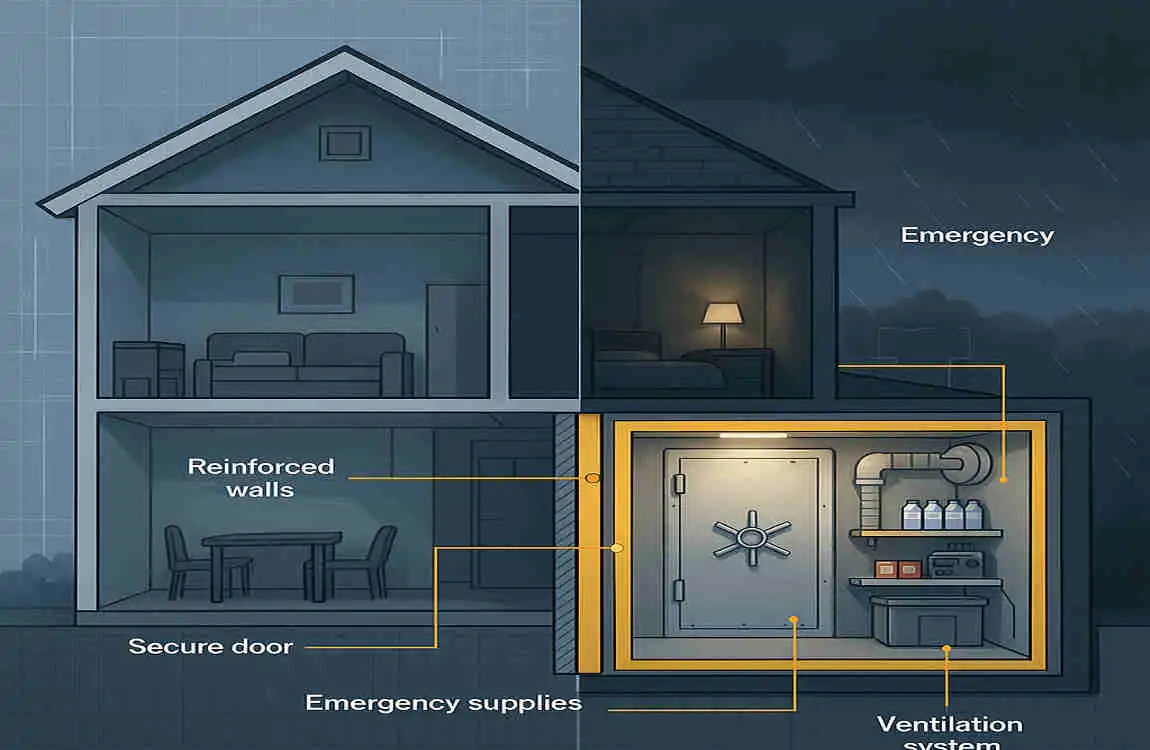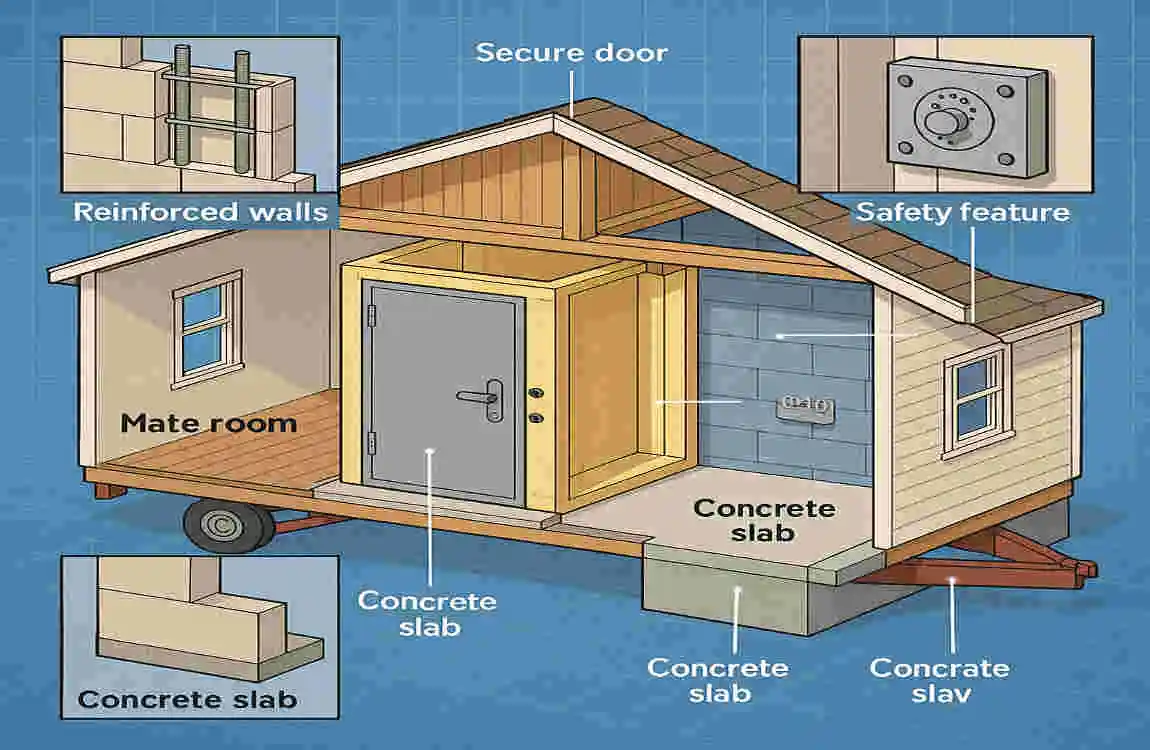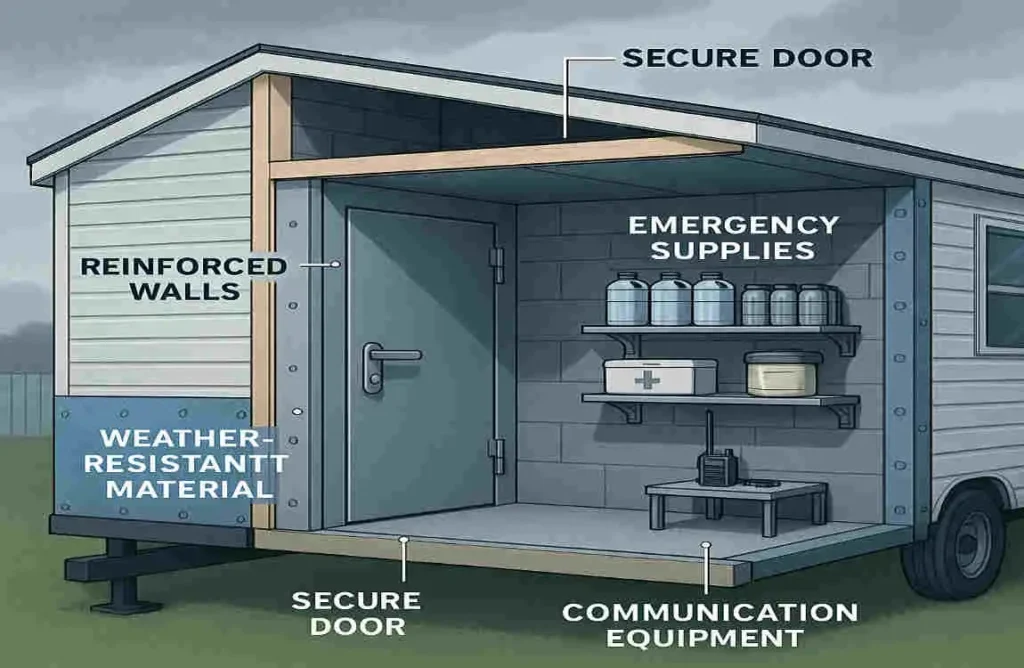In today’s unpredictable world, having a safe room in your mobile home can be a lifesaver. Natural disasters, break-ins, and emergencies are on the rise, and mobile homes can be particularly vulnerable. That’s why we’re here to guide you on how to build a safe room in a mobile home effectively.
Understanding Safe Rooms: What and Why?

What is a Safe Room?
A safe room is a specially designed space that provides maximum protection during emergencies. It’s built to withstand severe weather conditions, intruders, and other threats. Key features include reinforced walls, secure doors, and essential supplies.
Why Safe Rooms Matter for Mobile Home Residents
Mobile homes are more susceptible to damage from natural disasters and break-ins. A safe room can be a game-changer, offering a secure space to shelter in place until help arrives. It’s an investment in your safety and peace of mind.
Safe Rooms in Traditional Homes vs. Mobile Homes
While the concept of a safe room is similar, the construction process differs between traditional homes and mobile homes. Mobile homes have unique structural considerations and space limitations that must be taken into account when building a safe room.
Real-Life Scenarios Where Safe Rooms Save Lives
Imagine a tornado tearing through your neighborhood, or an intruder trying to break into your home. In these situations, a safe room can be the difference between life and death. We’ll share inspiring stories of how safe rooms have protected families during emergencies.
Assessing Your Mobile Home for Safe Room Construction
Evaluating Structure and Space Limitations
Before you start building, it’s crucial to assess your mobile home’s structure and available space. Consider the age of your home, the materials used in its construction, and any potential weak points.
Identifying the Best Location for a Safe Room
In a mobile home, the best location for a safe room is often an interior room or closet, away from exterior walls and windows. We’ll explore the pros and cons of different places and help you choose the right spot for your safe room.
Considerations for Foundation and Weight Limits
Mobile homes have specific foundation types and weight limits that must be taken into account when building a safe room. We’ll discuss how to reinforce your foundation and ensure your safe room doesn’t exceed weight limits.
Essential Materials and Tools Required
Strong, Lightweight, and Durable Materials
When building a safe room in a mobile home, you’ll need materials that are strong, lightweight, and durable. We’ll provide a list of recommended materials, such as reinforced steel, bullet-resistant drywall, and impact-resistant doors.
Tools Needed for Construction or Installation
Depending on your DIY skills and the complexity of your safe room design, you may need various tools for construction or installation. We’ll outline the essential tools you’ll need and provide tips on how to use them safely and effectively.
Safety Equipment for DIY Builders
Building a safe room requires working with potentially hazardous materials and tools. We’ll discuss the safety equipment you should wear, such as gloves, eye protection, and a dust mask, to keep yourself safe during the construction process.
Step-by-Step Guide on How to Build a Safe Room in a Mobile Home

Planning the Safe Room Size and Layout
The first step in building your safe room is to plan its size and layout based on the available space in your mobile home. We’ll guide you through the process of measuring your space and creating a design that maximizes safety and functionality.
Reinforcing Existing Walls and Ceiling
To ensure your safe room can withstand impacts and storms, you’ll need to reinforce the existing walls and ceiling. We’ll explain how to add extra layers of protection using materials like reinforced steel and impact-resistant panels.
Installing Secure, Reinforced Doors and Locking Mechanisms
A safe room is only as secure as its weakest point – the door. We’ll guide you through the process of installing a reinforced door and locking mechanism, specifically designed for mobile homes, to provide maximum protection against intruders and severe weather.
Adding Ventilation Without Compromising Security
While it’s essential to have a secure safe room, you also need to ensure proper ventilation to maintain a safe and comfortable environment. We’ll discuss how to add ventilation without compromising the security of your safe room.
Incorporating Communication Devices
During an emergency, communication is key. We’ll explore the best communication devices to include in your safe room, such as emergency radios, phones, and panic buttons, to keep you connected with help.
Electrical Considerations: Lighting and Power Supply
Your safe room should have a reliable source of lighting and power in case of an emergency. We’ll discuss how to incorporate electrical considerations into your safe room design, including backup power options.
Tips for Professional Assistance vs. DIY Approach
Building a safe room in a mobile home can be a complex project. We’ll provide tips on when to seek professional assistance and when a DIY approach may be suitable, helping you make the best decision for your situation.
Safety Features to Include for Maximum Protection
Blast-Resistant and Bulletproof Wall Enhancements
For maximum protection, consider adding blast-resistant and bulletproof enhancements to your safe room walls. We’ll discuss the available options and help you determine which ones are best suited to your needs.
Flood and Fire-Resistant Materials
Mobile homes are particularly vulnerable to floods and fires. We’ll explore the best flood and fire-resistant materials to include in your safe room design, ensuring you’re prepared for any emergency.
Secure Storage Solutions for Emergency Supplies
Your safe room should have secure storage solutions for essential emergency supplies, such as water, food, and first aid kits. We’ll provide tips on how to organize and store these supplies effectively.
Escape Routes and Alternative Exits
While your safe room should be secure, it’s also essential to have a plan for escaping if necessary. We’ll discuss how to incorporate escape routes and alternative exits into your safe room design, ensuring you have multiple pathways to safety.
Common Challenges and How to Overcome Them
Space Constraints in Mobile Homes
One of the biggest challenges when building a safe room in a mobile home is the limited space available. We’ll provide creative solutions for maximizing your available space and creating a functional safe room.
Budgeting Tips for Cost-Effective Safe Room Building
Building a safe room doesn’t have to break the bank. We’ll share budgeting tips and cost-saving strategies to help you make a secure room that meets your needs without straining your finances.
Navigating Mobile Home Structure Regulations and Permits
Before you start building, it’s essential to understand the regulations and permits required for constructing a safe room in a mobile home. We’ll guide you through the process of navigating these requirements and obtaining the necessary approvals.
Maintaining the Safe Room After Construction
Once your safe room is built, it’s essential to maintain it properly to ensure its continued effectiveness. We’ll provide a maintenance checklist and tips for keeping your safe room in top condition.
Cost Estimates and Budgeting Tips
Breakdown of Typical Costs
Building a safe room in a mobile home involves various costs, including materials, labor, permits, and additional safety features. We’ll provide a detailed breakdown of these costs to help you plan your budget.
Prioritizing Expenses Without Compromising Safety
When budgeting for your safe room, it’s essential to prioritize expenses without compromising safety. We’ll discuss how to allocate your funds effectively, ensuring you get the most critical safety features within your budget.
Resources for Potential Financial Assistance
If you’re struggling to afford a safe room, there may be resources available to help. We’ll explore potential financial assistance options, such as community programs and grants, to help you build a safe room without incurring significant costs.
Legal and Regulatory Considerations
Building Codes and Mobile Home Regulations
When building a safe room in a mobile home, it’s crucial to comply with building codes and mobile home regulations. We’ll provide an overview of these requirements and help you ensure your safe room meets all necessary standards.
Obtaining Necessary Permits and Inspections
Before you can start building your safe room, you’ll need to obtain the necessary permits and inspections. We’ll guide you through the process of applying for these permits and preparing for inspections, ensuring your project stays on track.
Insurance Benefits of Installing a Safe Room
Installing a safe room in your mobile home can have insurance benefits. We’ll discuss how a safe room can lower your insurance premiums and provide additional coverage in the event of an emergency.
Maintaining and Testing Your Safe Room
Routine Inspection Checklist
To ensure your safe room remains effective, it’s essential to perform routine inspections. We’ll provide a checklist of items to inspect regularly, helping you identify and address any potential issues that may arise.
Testing Security Features and Emergency Protocols
In addition to regular inspections, it’s crucial to test your safe room’s security features and emergency protocols. We’ll discuss how to conduct these tests and ensure your safe room is ready for any emergency.
Updating Emergency Supplies and Equipment
Your safe room should always have up-to-date emergency supplies and equipment. We’ll provide tips on how to rotate and replenish your supplies, ensuring you’re always prepared for an emergency.
